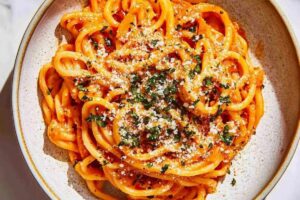Description
Spicy Korean Gochujang Noodles dance with bold flavors, bringing fiery chili heat and silky noodle comfort to your plate. Rich umami sauce coats tender noodles, inviting you to savor an unforgettable culinary adventure from Seoul’s remarkable street food scene.
Ingredients
Scale
Main Ingredients:
- 8 ounces (226 grams) udon, ramen, or rice noodles
- 1/2 cup (75 grams) protein of choice (tofu, chicken, or shrimp) (optional)
- 1 bell pepper, thinly sliced
- 1 medium carrot, julienned
- 1 cup (85 grams) bok choy, chopped
Sauce Ingredients:
- 2 tablespoons gochujang (adjust to taste)
- 2 tablespoons soy sauce (or tamari for gluten-free)
- 1 tablespoon sesame oil, plus more for garnish
- 1 tablespoon honey or brown sugar
- 1 tablespoon rice vinegar
- 2 cloves garlic, minced
- 1 teaspoon fresh ginger, grated
Garnish and Cooking Ingredients:
- 1 tablespoon neutral oil (such as vegetable or avocado oil)
- 1/4 cup reserved noodle cooking water (as needed)
- 1 tablespoon sesame seeds, for garnish
- 2 green onions, chopped, for garnish
Instructions
- Prepare a large pot of water and submerge noodles, cooking until they reach an al dente consistency. Carefully drain and reserve the cooking liquid.
- Craft a vibrant sauce by blending gochujang, soy sauce, sesame oil, honey, rice vinegar, minced garlic, and grated ginger in a mixing vessel. Taste and fine-tune the flavor profile for optimal balance.
- Select a spacious skillet or wok and warm neutral oil over medium-high heat. If incorporating protein, sear until completely cooked through, then transfer to a separate plate.
- Introduce bell peppers, carrots, and bok choy into the heated pan, sautéing rapidly to maintain a crisp-tender texture and preserve their vibrant colors.
- Pour the prepared sauce over the vegetables, then gently fold in the cooked noodles, ensuring each strand is thoroughly coated with the spicy, umami-rich mixture.
- If the sauce appears too thick, incorporate a small amount of reserved noodle water to create a silky, glossy consistency.
- Reintroduce the cooked protein into the pan, stirring to distribute evenly and heat through.
- Elevate the dish’s visual appeal and flavor by sprinkling toasted sesame seeds and finely chopped green onions. Finish with a delicate drizzle of sesame oil.
- Transfer to serving plates immediately and enjoy the harmonious blend of textures and flavors.
Notes
- Choose fresh, high-quality gochujang for a more authentic and vibrant flavor profile that elevates the entire dish.
- Customize protein options by swapping between tofu, chicken, shrimp, or beef depending on dietary preferences and nutritional needs.
- Adjust sauce spiciness by increasing or decreasing gochujang quantity, allowing flexibility for heat-sensitive palates.
- Boost vegetable nutrition by adding extra seasonal vegetables like mushrooms, spinach, or zucchini for increased texture and wellness benefits.
- Prep Time: 10 minutes
- Cook Time: 10 minutes
- Category: Lunch, Dinner
- Method: Sautéing
- Cuisine: Korean
Nutrition
- Serving Size: 2
- Calories: 430
- Sugar: 8 g
- Sodium: 800 mg
- Fat: 14 g
- Saturated Fat: 2 g
- Unsaturated Fat: 10 g
- Trans Fat: 0 g
- Carbohydrates: 63 g
- Fiber: 4 g
- Protein: 12 g
- Cholesterol: 30 mg
